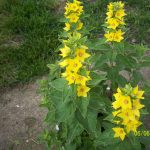Q) This flower/weed came up in my flower garden this year. I know that I did not plant it and two other people said that they have it growing in their yards also. I took it to our local nursery. They did not know what it was and looked it up in their books but could not find it. They gave me a few suggestions but when I looked them up on the internet, they did not match. Would you be able to identify this plant and let me know if it is just a weed that I need to be aware of or if it is indeed a flower of some sort? – L.B., Noble County
A) Weed is in the eye of the beholder. Some welcome this plant’s presence while others consider it an aggressive weed. This is a yellow loosestrife, Lysimachia, either L.punctata or L. vulgaris. These species are quite similar, with L. punctata blooming along the stem in the leaf axils while L. vulgaris blooms primarily at the top of the stems. Both species are herbaceous perennials that are native to Europe and Asia but escaped cultivation and naturalized in many areas of the U.S. and Canada. Yellow loosestrife thrives in sun or part shade. Lysimachia vulgaris is classified as an invasive species in some states and is particularly invasive in wetland habitats. Both species spread and overwinter by rhizomes (underground horizontal stems) and by seed. Yellow loosestrife is likely to wear out its welcome even if you initially appreciate its beauty. So if you choose to keep it, place it only in an area where it will not invade natural areas or your other perennials. Despite its name, yellow loosestrife belongs to the primrose family, not the loosestrife family that includes the notoriously invasive purple loosestrife.
Q) We seem to have termites attacking our rhubarb. I plan to drop a sample (gathered yesterday) at the local Purdue Extension office shortly. Any recommendations? – F.M., Greene County
A) Termites are not likely to be attacking rhubarb, since termites eat wood rather than live plants. If your rhubarb happens to be around an old decaying fence, landscape timbers or other wood scraps that would support termites, the termites could be cohabiting with your rhubarb. But it is more likely that the insects in question are not termites, but possibly ants. Ants are also not going to attack rhubarb, but they do often build nests in association with perennial plants. You’re on the right track to have the insects in question properly identified at your local Purdue Extension office. In the meantime, Purdue Entomology Extension has an excellent publication on ants that includes a discussion of how to distinguish ants from termites. See https://extension.entm.purdue.edu/publications/E-22.pdf for additional information.
